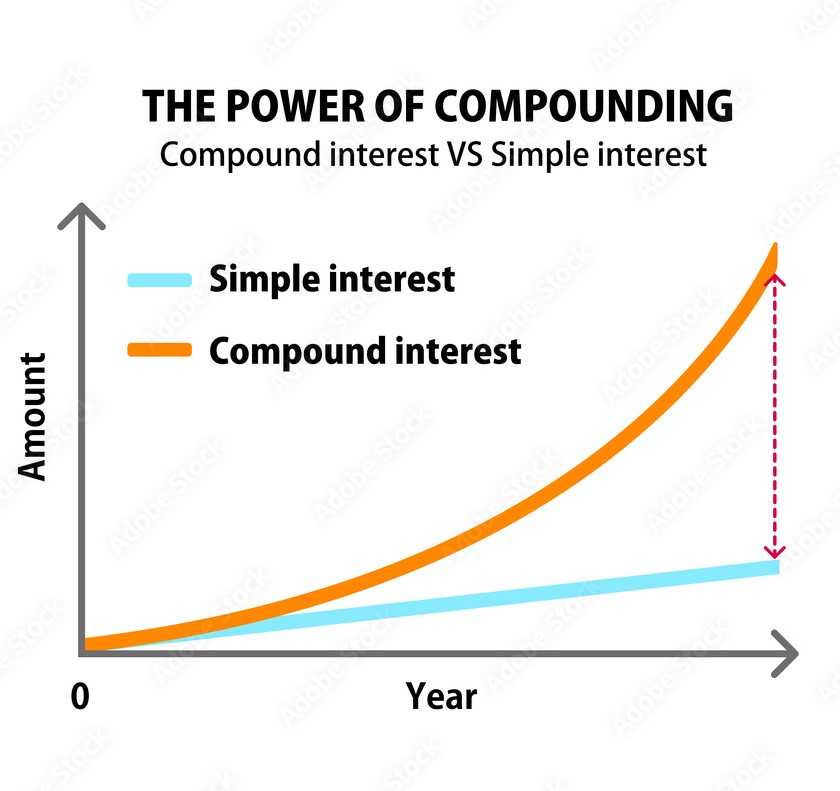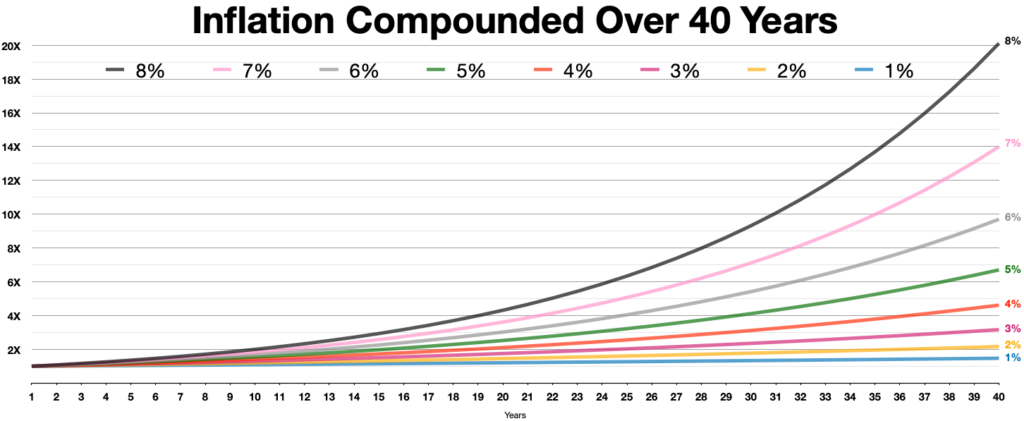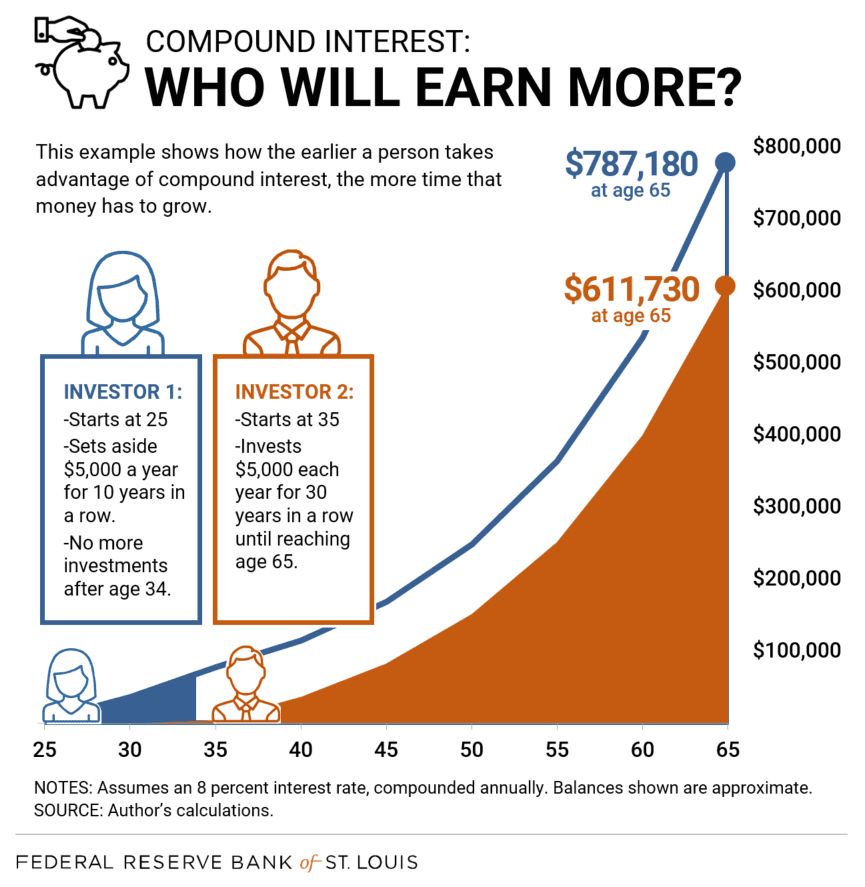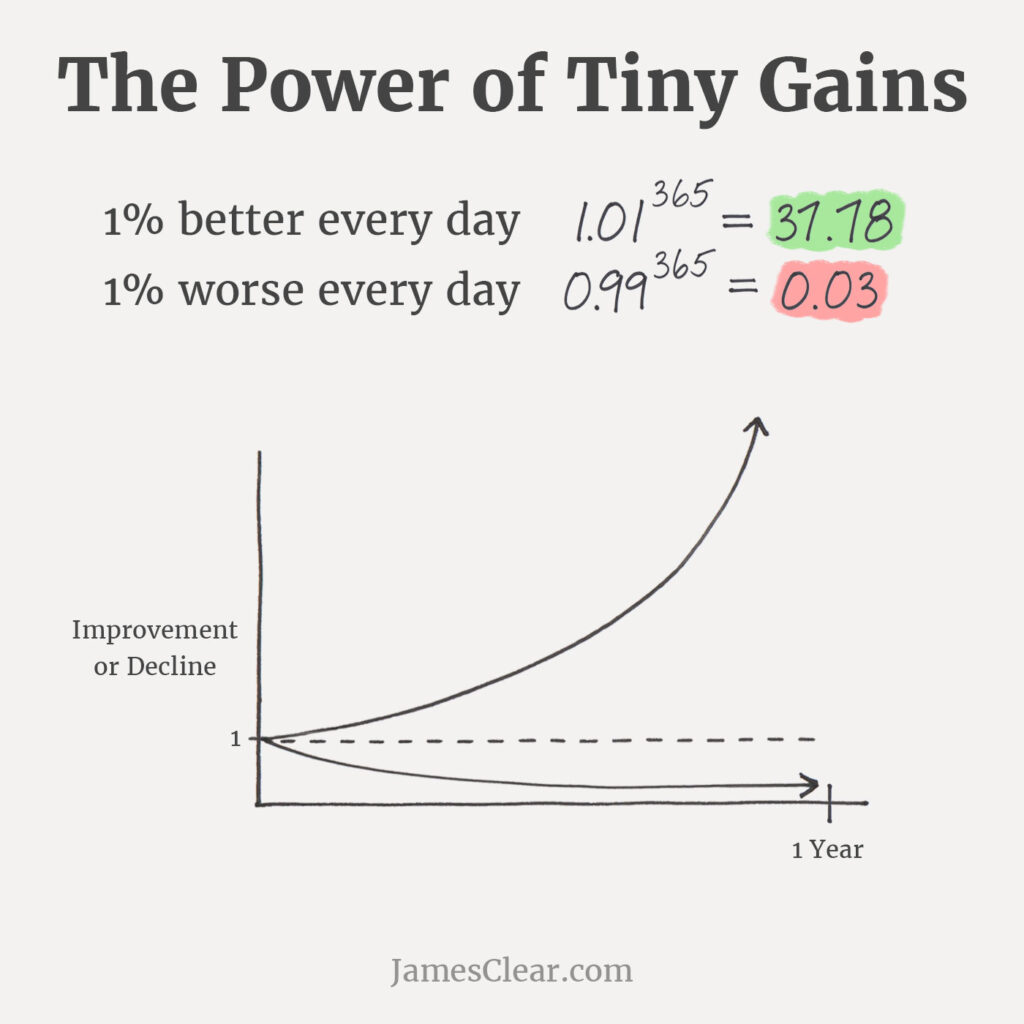Albert Einstein once said: “Compound interest is the eighth wonder of the world. He who understands it, earns it; he who doesn’t, pays it”.
Compounding is the process by which we add interest to the original sum, which then earns interest on the previous sum and the newly added interest, and then earns interest on that amount, and so on and so on. In other words: interest on interest.
This leads to exponential growth (or decline), rather than linear, or additive, growth.

The magnitude of compounding – the exponential effect – depends on 4 factors:
- Time – how much time does the compounding have to take place? The longer you let it happen, the larger the effect.
- Growth or decline rate – at which growth rate does the investment increase? The higher the percentage, the larger the effect. (see graph below)
- Frequency – how often does the compounding take place? The more frequent, the larger the effect. Example: compounding daily has a greater outcome than compounding weekly.
- Recurring investment – do you add additional amounts of money during the compounding process? If yes, each of these added amounts will start compounding as well, increasing the total value at the end.

The above graph shows inflation compounded over 40 years at different growth rates. It clearly demonstrates how higher growth rates lead to significantly greater results than lower growth rates.
The longer you let an investment compound, the greater the end result. Said differently: the earlier you start investing, the longer you can benefit from the exponential effect of compounding. This notion leads to the time value of money: the earlier you own and start investing money, the greater your financial wealth will be at the end.
Compounding is most often used this way: to talk about money and investments. But money isn’t the only thing that compounds. Any other asset can compound as well: your knowledge, your skills, your ideas, your relationships.
Any improvement you make personally, in business or in your relationships stacks on top of improvements you’ve made in the past. As with money, the earlier you start working on personal development or improving your relationships, the more often you work on it and the longer you keep it up, the greater the result will be.
The reverse is also true: the later you start, the less you do and the less time you give it (you quit early), the weaker the result.
The good thing is: even if you start late, you can still “catch up” to others who started earlier if you have a greater growth rate (using better resources or mentors for example) or if you improve more frequently (spending 8 hours per day improving while others only spend 2 in that area). In other words: You’re never too late to start.
As they say: The best time to start was yesterday. The next best time is now.
How to use Compounding
Money: The below graph explains everything.

In other words: no matter how little you can invest, start investing early with whichever amount you have at your disposal. And, preferably, invest consistently for some time.
Personal development and skills/knowledge: just as money compounds, so do knowledge and skills.
The earlier you focus on personal development, the more time/effort you dedicate toward it, the more often you do it and the longer you keep it up, the greater the result will be.
Unlike money, we cannot express our own abilities and growth in easy-to-understand numbers. And since the external world takes longer to notice our improvements, opportunities and results (the consequences of our personal development) tend to come slow.
It is those who, despite the limited results early in life, consistently and patiently improve themselves over a longer period of time that ultimately have the biggest gains (success, wealth, etc) in life.
As the below graph by James Clear shows, a 1% improvement (in anything) every day, leads to a 3778% improvement after 1 year. In other words: you’ll be 37x “better” than you were a year ago.
On the flip side, a 1% decrease every day leads to a 0.03x outcome at the end of the year. In other words, you’ll have gotten worse by 97%.
What starts as a small win or a minor setback accumulates into something much more, if done consistently over time.

So how can you improve yourself?
- Improvement by addition: do more of what works (and what you’re already doing).
- Improvement by subtraction: avoid tiny losses and eliminate what doesn’t work. Examples:
- Avoid stupid mistakes or make fewer mental errors. How: avoid getting into situations in which you’re likely to make mistakes and/or improve your ability to think and judge situations appropriately.
- Improve your health by eating less unhealthy food.
- Improve your strength by missing fewer workouts.
- Measure backward: start with the end in mind. Rather than focusing on goals and milestones, think about the outcome you want, then work backward to figure out how to get there. Then ask yourself: what did I do yesterday (or last week) and how can I improve it just a little bit tomorrow?
Business development: like the 1% improvement in personal capabilities, the same applies to a business. Since a business consists of more measurable components than a person, the effects of compounding and exponential growth are even more noticeable.
Improving one aspect of your business consistently leads to outsized returns, but, even more interesting, is the ability to slightly improve two or three aspects in your business and gain instant exponential growth. The sum (of the improvements) is greater than the parts.
Let’s take a simple example:
Company A has:
- 10 clients
- Who each purchase 10 times
- With each purchase being $10 on average
The total revenue for company A is 10 x 10 x $10 = $1000.
Now if we improve each component by 10%, you might expect the total improvement to be 30% (10% + 10% + 10%). But it’s not.
After improving each component by 10%, company A has:
- 11 clients
- Who each purchase 11 times
- With each purchase being $11 on average
The total revenue for company A is 11 x 11 x $11 = $1331
In other words: improving these 3 components by 10% each doesn’t lead to a 30% increase, but a 33% increase!
Relationships: the longer your relationship with someone, if healthy, the stronger it will be.
It takes a lot of effort at first to obtain a new relationship and foster it, but over time it takes less time and effort to maintain it. And the longer your relationship, likely the stronger the trust and the greater the benefits will be. It’s more likely that someone gives you opportunities, refers you to others or invites you to something exclusive, if you’ve been in a long-term relationship with each other.
You’d likely do the same: would you give an opportunity to a stranger or a childhood friend who you know and trust?
An interesting way to use the power of compounding is with referrals: whenever you’ve helped (or interviewed) someone, ask that person to introduce you to two others. Ask the same to those two (after helping them). Your network will grow exponentially (2x) rather than linearly (2 + 2) as each new introduction leads to 2 more introductions.